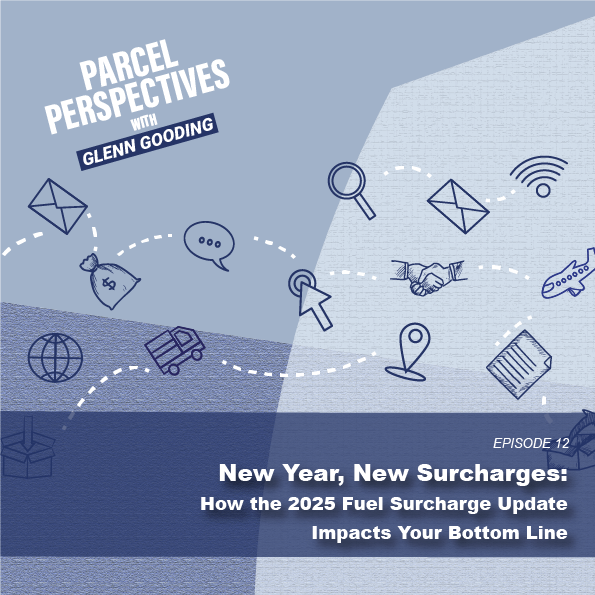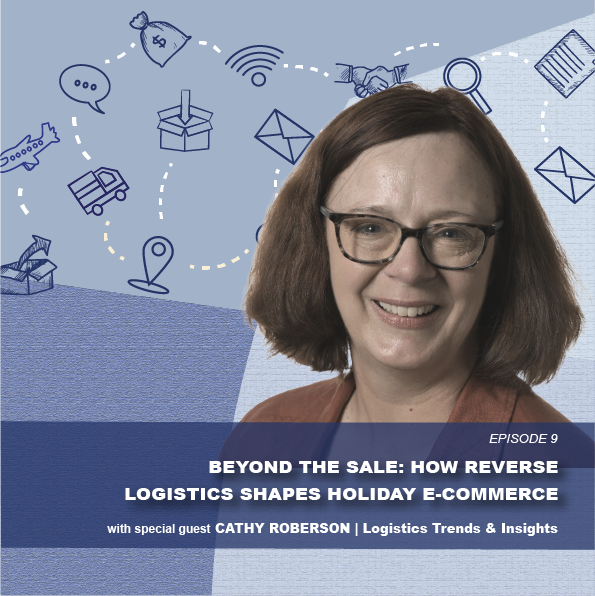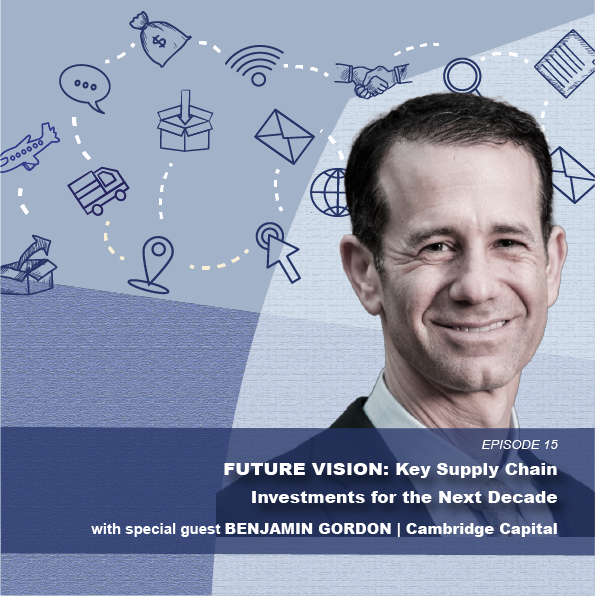New Year, New Surcharges: How the 2025 Fuel Surcharge Update Impacts Your Bottom Line
Dive into the complexities of fuel surcharges with Glenn and learn how recent 2025 increases by carriers like UPS and FedEx are reshaping the cost landscape for small parcel shippers. Gain insights into strategic responses to manage and mitigate these rising expenses in this insightful episode of Parcel Perspectives.
Listen on:

Notes
Join Glenn Gooding in this revealing episode of Parcel Perspectives as he tackles the escalating fuel surcharges reshaping the small parcel shipping landscape. Discover how recent hikes by giants like UPS and FedEx are intensifying shipping costs and what it means for shippers struggling to manage these changes. With a spotlight on the surprising growth of Amazon Logistics and the challenges faced by traditional leaders, this episode unpacks the strategic implications behind rising prices amidst falling volumes.
Glenn leverages his 37 years of industry expertise to provide a deep dive into the financial burdens these surcharges impose, illustrating how they now account for 25-40% of total shipping expenses. Through analysis from 2021 to 2024, uncover how these costs stack up and explore effective strategies to mitigate their impact. Whether you’re a seasoned shipper or new to the industry, Glenn’s insights will equip you with the knowledge to navigate these turbulent waters and secure a competitive edge.
Tune in to Episode 12 of Parcel Perspectives for essential strategies on staying informed and proactive in the face of rising shipping costs.
Transcript
Glenn Gooding [00:00:02]:
When we think of 2024, I can tell you that UPS and FedEx are down on average daily volume. If you listen to their earnings reports, you know that and they’re clamoring for bringing in more profitable business. What I find ironic about that is that in light of trying to win business, their answer seems to be impose more cost increase and let’s do it in a more opaque manner. Let’s make it harder for shippers to qu. Quantify, understand, compress.
Glenn Gooding [00:00:39]:
Welcome to Parcel Perspectives, the podcast dedicated to small parcel shippers. I’m Glenn Gooding and each episode we dive into insights, best practices and strategies to help you navigate this complex, costly market. Join me as we explore ways to strengthen your long term partnerships with your chosen carriers and stay competitively aligned.
Glenn Gooding [00:01:06]:
Hi folks, thanks for joining me for another condensed version of Parcel Perspectives. I’m Glenn Gooding, president of iDrive Logistics. Wanted to offer you kind of a unique insight. Kind of Glenn Gooding’s editorialized announcement around some more fuel increases being brought into the marketplace. And I kind of want to give you a bigger, more comprehensive picture of what it means, kind of what’s happening in the marketplace. Along with some of my editorialized comments. I hope you find it valuable. So UPS has recently announced yet another change to their fuel surcharge.
Glenn Gooding [00:01:48]:
They’ve changed both the table as well as this associated surcharge amount. It’s going up another 125 basis points. So if it were 15% it would now be 16.25. Or if it were 16.25 it would now be 17.5. You get it? And I have both FedEx and UPS up here because I am not here to beat up on UPS alone or I’m not here to beat up on FedEx alone. They are the historic, the legacy national small parcel carriers that have dominated the U.S. north American marketplace recently had some more competition out there. But if you’re for example, a B2B shipper, really hard to divorce yourself of one or the other of these carriers or both.
Glenn Gooding [00:02:35]:
And it’s being exploited a little bit. So I kind of want to share some things that I’m seeing there. For starters, let’s talk about the market share of U.S. small parcel volume. And we look back as far as 2014 all the way to as recently as 2023. I find this interesting. I find it illuminating and somewhat ironic. For starters, there’s a carrier here by the name of Amazon.
Glenn Gooding [00:03:02]:
I know we’ve all heard of them. In 2014 they were not on the map the green line you see on this graph, what you do have are the big three of that time frame. USPS, UPS, FedEx. USPS has always been the dominant carrier. First Class, Parcel Select, Priority Mail. And that’s morphed into Ground Advantage and other things there. But they’ve always had a dominant position but not a good place in kind of the traditional B2B or the traditional 1 to 71 to 150 pound weight range. They played a niche.
Glenn Gooding [00:03:41]:
UPS was far and away the dominant carrier from a market perspective at just over 30% of the market back in 2014. FedEx followed suit at about 25% of that market. Now what I find interesting about this as we move through this timeframe is number one, the onset of Amazon Logistics as a provider. We go forward to 2023. Please note, I know we’re almost in 2025. I think these numbers would slightly continue on these trends. But Amazon Logistics has moved from non existent in 2014 to the second largest delivery provider by volume in the US market. UPS has moved to third and lost considerable market share.
Glenn Gooding [00:04:28]:
FedEx is now in fourth place. Now what I find particularly interesting about this is if you’ve heard me before, I’ve talked about the legacy small parcel market as this duopoly. It’s really a UPS versus FedEx. It has been for some time. Some other things I’ve talked about is that the small parcel market always seems to get more complex and more expensive every single year. That was exacerbated by what I call this duopoly. So historically, what we’ve seen and it seems to continue to hold true, what FedEx does in the marketplace, UPS follows suit, or vice versa. What UPS does in the marketplace, FedEx similarly follows suit.
Glenn Gooding [00:05:15]:
What this complexity and what this expense has done is it’s opening the door for innovation, it’s opening the door for competition. Market share is indicative of that. When we think of 2024, I can tell you that UPS and FedEx are down on average daily volume. If you listen to their earnings reports, you know that and they’re clamoring for bringing in more profitable business. What I find ironic about that is that in light of trying to win business, their answer seems to be impose more cost increase and let’s do it in a more opaque manner. Let’s make it harder for shippers to quantify, understand, compress. So what I have here is a date range going back to March of 2021. And I want to walk you through exactly what is happening or has happened in the marketplace with Regard to just fuel surcharge and bigger picture on fuel surcharge.
Glenn Gooding [00:06:17]:
If you were to look at your total spend with a carrier transportation spend being the dominant piece and then you think of accessorials and surcharges, without question the number one category, with very rare exception, would be fuel surcharge. Fuel surcharge would be the dominant surcharge. Expense and accessories and surcharges traditionally make up somewhere between 25 and 40 40% of your total spend. What you’re writing a check to UPS or FedEx for now, fuel over the last two and a half years, three years has undergone a massive amount of increases. You may not have known that, so I want to highlight that to you. What I have here is an illustrative actual example of showing you what fuel has done if the cost of on highway diesel per gallon price on the National Department of Energy website were trading at a static rate throughout all of this time. So if Diesel were at $3.55 a gallon in March 1st of 2021, you as a shipper would have paid an 8.75% surcharge for ground shipments over the course of this time several iterations on each diesel date here. This is specific to UPS’s dates of when they made the changes, but remember, FedEx has followed suit.
Glenn Gooding [00:07:41]:
Similarly, you’ve seen 25 basis point increase 75 basis point 100175 in 3-11-2022 125 now in 1223 all in that becomes 900 basis points of increase. So that at 355 a gallon in 2021 you’d paid 8.75% fuel surcharge in the end of 2024 that would be 7.75%. Crazy crazy crazy. So let’s put an example out there. I love pictures and so I want to walk you through an overly simplified example. Let’s grab a typical package, a ground residential zone five 10 pound parcel. Let’s imagine that that total expense, transportation, resi surcharge, everything all in $11.50 3-1-2021. Fuel on that parcel would have been $1.01 for $12.51.
Glenn Gooding [00:08:47]:
You fast forward to 12-23-2024 and consider a very generic general rate increase. Let’s say 5.9% every single year. Over the course of this timeframe the transportation and resi surcharge would have gone from 1150 to 1446 25.7%. Over that timeframe fuel would have gone from $1.01 to $2.57. A 155% increase. Total effect on that parcel, 36.1% increase. So if you’re ever wondering how UPS and FedEx are trying to make up their volume shortfalls, they’re doing it through this methodology. Similar example down below, without a gri.
Glenn Gooding [00:09:34]:
So we just isolate the effect of fuel. If there were no general rate increases in the marketplace from March 1, 2021 to now, you still on that same parcel, would have incurred an 8.3% increase over that timeframe. 103% on fuel. The fuel increase is not always static. Now what I have here is trying to show you that they’ve continued both UPS and FedEx to manipulate the table, the range, the cost of fuel range. They’re trying to mitigate themselves against a declining fuel market and they’re doing some things with a rising fuel market as well. What I have here under the BP increase, right, is what the basis points increase are for an associated cost. So we’ve talked about a 125 basis point increase, which falls in a couple areas here.
Glenn Gooding [00:10:31]:
16.25 to 17.5, 17 to 18.25 at these cost amounts for cost of diesel. But if you have a declining fuel market, that can be more pronounced. 150 basis point, 175, 200 basis points. Same goes for a heavily escalating fuel market. So it’s not always static, it’s not always linear, and the carriers are doing things to mitigate their risk in a moving fuel environment. What does that look like over time? What I have graphed here, again trying to give you some graphics and some pictures, is the cost of diesel. And then on the other axis across the way is the associated fuel surcharge. What we’re beginning to see is a continuing growing gap between the associated fuel surcharge and the cost of diesel, indicative of the 900 basis points I’m talking about.
Glenn Gooding [00:11:34]:
The question now becomes, and I’m assuming you’d be asking is Glenn, where does this end? Great question, glad you asked. Let’s look at my last slide. This is some of our LTL carriers out there. Here is Glenn Gooding’s personal theory on the fuel surcharge strategy being employed by UPS and FedEx. My thought is that most of you transportation professionals out there really have pretty good chops when it comes to truckload and less than truckload. And being that you’re good skilled procurers in that space, you’re intimately familiar with the fuel surcharges in those modes. I believe you’re being taken advantage of that. You’re being apathetic to what you see in the freight market.
Glenn Gooding [00:12:24]:
So what I have pulled up here are the associated fuel surcharges in the LTL environment. What you can see here are fuel surcharge ranges that range somewhere in the 29 to 30% range. So if you were to ask me point blank, Glenn, where does this end? I believe it ends when the ground fuel surcharge for the small parcel carriers UPS and FedEx comes to parity with the LTL fuel surcharge. I think they’re attempting to improve revenue on a year over year basis, appease the investing community and appease you as skilled procurers. Any of you who have been out in the marketplace recently and negotiated agreements with either of those carriers are probably proud of the fuel surcharge discount you now have. A few years ago that would have been a much harder thing to get. You ever wonder why? Because they’ve imposed 900 basis points of increase in there, it now becomes an elegant negotiable. So the final question you might ask is great information Glenn, what in the world can I do about this? Well, one is you need to understand it’s happening.
Glenn Gooding [00:13:40]:
Secondly, you need to understand what the quantifiable financial impact is to your business. And lastly, you need to devise a strategy of how you competitively align in this very competitive market that we have today. Don’t forget it’s still expensive and it’s still complex. But if you do that, you will begin to operate from a position of knowledge and information. And then contingent on your size and what you can do, there might be some creative ways you can mitigate your risk around these fuel surcharge tables. If you’d like to discuss this with me in greater detail specific to your case, I look forward to hearing from you. Happy to be a resource. Hope you found this valuable and I hope you’re enjoying the holiday season and it’s gone smoothly for you.
Glenn Gooding [00:14:27]:
Take care. Thank you for another episode of Parcel Perspectives. Please remember if you like this episode, please like it. Please recommend it to your friends. Look forward to adding further value for you throughout 2025. Take care.
Glenn Gooding [00:14:47]:
Thanks for listening to Parcel Perspectives hosted by me, Glenn Gooding. I’ve been in the small parcel space for 37 years. Starting with a deep and broad background working for one of the major carriers as an operator and industrial engineer. Later managing pricing at the highest level for the largest, largest, most complex shippers in the world. Since then I’ve been a national thought leader and work to help drive strategy for clients from Fortune 50 companies to startup e commerce businesses, helping them more competitively align in this complex and expensive market.
Glenn Gooding [00:15:19]:
If you enjoyed the show, please subscribe.
Glenn Gooding [00:15:21]:
And share with friends. Join us next time for more expert advice and strategies to stay ahead of the shipping game.
Key Topics with Timestamps
- 00:00 UPS and FedEx Surcharge Increased by 125 Basis Points
- 06:17 Dominance of Fuel Surcharges in Transportation Costs
- 10:31 Diesel Costs vs. Fuel Surcharges: Non-linear Trends
- 12:24 Fuel Surcharge Parity: A Revenue Strategy
- 14:47 Strategic Shipping Insights from Parcel Expert
Other Podcasts
-
Beyond Logistics: A Consultant’s Role in Supply Chain
Discover how logistics consultancy revolutionized small parcel shipping for Right Manufacturing Systems in this episode of Parcel Perspectives. Join Glenn Gooding and Ian Hartman as they discuss achieving a 23% reduction in shipping costs, leveraging...


